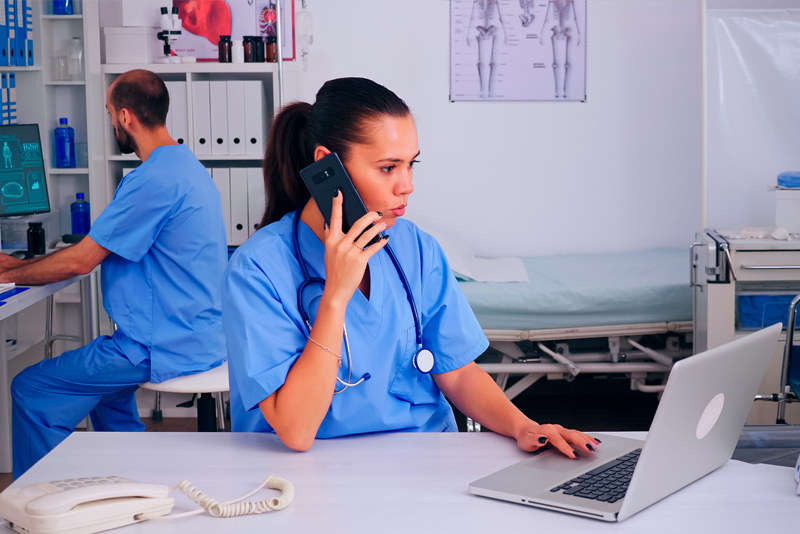
Remote patient monitoring (RPM) is the use of digital health devices to monitor and capture health data from patients and transmit this information to healthcare providers for assessment and care recommendations. Connected health devices include everything from wearable heart monitors, blood glucose meters, spirometers and pulse oximeters to ECG machines Fitsbits, and Bluetooth-enabled scales. By tracking patients’ blood pressure, glucose levels, temperature, weight, pulse, oxygen levels, and other vital health data via RPM, physicians can keep an eye on them between office visits. With the COVID-19 pandemic, RPM and telehealth adoption saw a surge, helping connected patients receive continuous care at home. Medical transcription companies provide accurate and timely documentation of these virtual encounters in the electronic health record (EHR).
However, according to a recent Medical Economics article, most RPM solutions have not lived up to expectations because they are not developed specifically with the senior population (75 and older) in mind. Many older adults have serious chronic conditions such as high blood pressure, diabetes, and congestive heart failure which require consistent monitoring and easy access to care. The report lists several reasons why RPM does not work effectively for seniors:
- They do not have unrestricted and high-speed internet connectivity.
- They are technology challenged – they may not always have the help they need to use digital technology.
- The technology they are provided with is not sufficient for their needs because “designed for another primary use and retrofitted for RPM”.
Given these issues, let’s take a look at the key considerations for effective implementation of RPM:
- Proper planning and coordination between teams involved: According to a HealthTech Magazine report, proper RPM planning requires both the participation of the clinical group as well as the IT team. The clinical group should identify the patient population that will be monitored, the problem it’s trying to solve with RPM, and how monitoring will be done. The IT team should handle the technicalities as clinicians usually don’t have experience in this area.
- Communicate the objectives of RPM clearly: To ensure participation, both clinicians and patients should clearly understand the goals and processes of RPM. Patients should know how they can convey their measurements electronically. Clinicians must be able to identify patients who are having problems. There should be processes in place to handle emergencies.
- Implement simple, customized at-home RPM solutions: To connect with patients, facilities should use simple, easy to operate RPM options like structured discharge phone calls or an automated phone system. Tablets or iPads modified as RPM consoles or equipment retrofitted from use in hospitals would be too complex for seniors to handle. Even the highest sound level on a tablet would not be audible to seniors with hearing problems. There are simple RPM approaches for a range of diseases, from congestive heart failure (CHF) to diabetes and monitoring these conditions remotely using simple approaches allow for quick interventions such as changing medication prescriptions or increasing the dosage.
- Choose the most suitable device: The digital literacy of seniors is a very real concern when it comes to embracing healthcare technology. In a recent survey, 61% of physicians reported that lack of digital literacy among patients is a major hurdle to telehealth. Ease of use, especially by seniors, is critical to boost adoption. Here are some recommendations with regards to this:
- The RPM device must be “plug and play” without a complicated setup.
- Vital sign monitors must be pre-set and work without a hitch when patient use them.
- Voice communications should be automated and foster patient engagement.’
- It should be possible to activate two-way communications at the push of a button.
- Using RPM cellular devices is a good option as they are faster, and reliable internet access is not required.
- Leverage AI and automation: The continuous monitoring of multiple parameters would result in the rapid increase in unprocessed and unorganized data available for clinical decision-making. AI can help healthcare providers extract actionable information from this data. AI powered data analytics is crucial to take advantage of innovative trends in patient monitoring technology such as smart prosthetics and smart implants for patient management post-surgery or rehabilitation, solutions for wound management and cardiac monitoring, and brain-computer interfaces to monitor and evaluate patients’ psychological, emotional and cognitive state. Advances in AI and automation also allow patients to easily connect directly with a healthcare provider and for the clinicians to respond.
- Round-the-clock monitoring: To ensure that patients have access to 24/7 care, RPM providers must partner with a care management company that monitor patients and deliver the physicians’ protocols (www.medicaleconomics.com). Both stakeholders work to implement and incorporate RPM into current physician workflows for enrollment and care delivery services.
- Offer comprehensive solutions: Utilizing multiple tools to track their health can be difficult and confusing for seniors. They should be provided with complete solutions such as blood pressure monitors and oxygen sensors that integrate easily with the system and each other.
The pandemic exposed the need for the rapid adoption of increasingly innovative digital health technologies. According to a recent mhealthintelligence news report, with the surge in the popularity of RPM, telehealth advocates are lobbying the Centers for Medicare & Medicaid Services (CMS) to improve proposed coverage plans in the 2022 Physician Fee Schedule. As healthcare facilities work to implement innovative strategies to connect with and care for patients at home, they can rely on an experienced US based medical transcription company to document virtual consults in the EHR.


